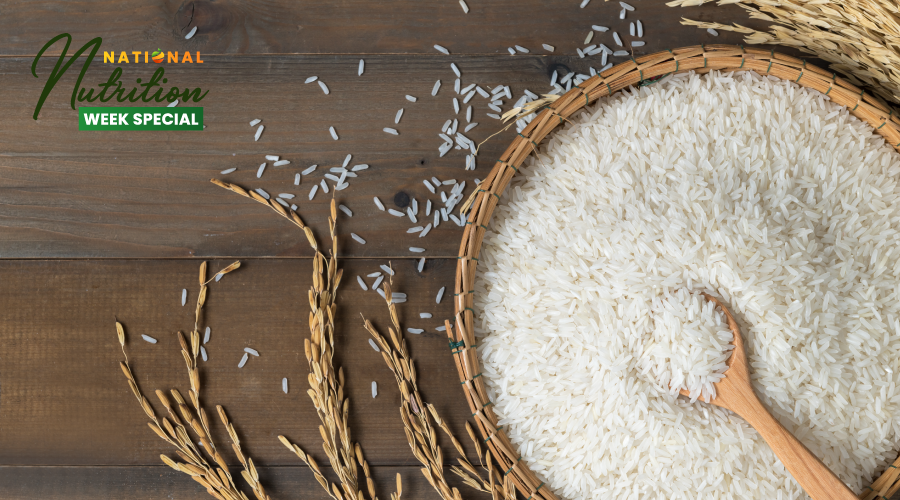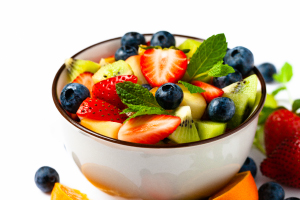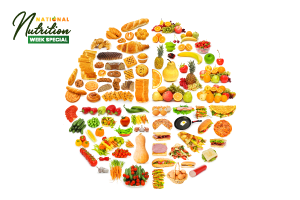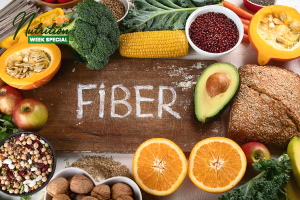

Rice is a cholesterol and gluten-free source of complex carbohydrates. It has zero fat and very low sugar and is consumed as a staple food in different forms globally. It is a cereal that comes under the subcategory grain. Carbohydrates in rice are present in good quantities, which makes them a good source of energy.
Starch is the major carbohydrate found in rice. It takes a longer time to digest and therefore provides energy for longer durations. Fibre content in rice helps maintain gut health and keeps your bowel movements healthy. Other than carbohydrates in rice, other nutrients are also present including, the protein that satiates your stomach and makes you feel full for longer durations.
White Rice vs Brown Rice: Complex Carbs Made Easy to Understand
When it comes to rice, the most common question is, what kind of rice is better – brown or white.
Grains, in their original form, are composed of three components – bran, endosperm, and germ. Bran is the outer layer or coating, endosperm is the food supply that provides energy to the young plant, and germ is the embryo. A grain is considered as whole grain when all the three components are present in the same proportion as that in the plant. When the whole grain is processed to remove the bran and germ, we obtain refined grain.
White rice is a type of refined grain whereas brown rice is a whole grain. Since the bran is rich in fibre, brown rice has high fibre content and hence takes a comparatively longer time to digest. It is usually believed that brown rice is very healthy and white rice is unhealthy.
Carbohydrates in Rice
Let’s take a look at the value of carbohydrates in rice for each type, specifically in cooked form as per the U.S. Department Of Agriculture (USDA):
- 21 grams carbs per 100 grams of white, glutinous rice (most common in Asia)
- 23 grams of carbs per 100 grams of brown, long-grain rice
- 26 grams of carbs per 100 grams of white, parboiled, long-grain rice
- 28 grams of carbs per 100 grams of white, long-grain rice
- 29 grams of carbs per 100 grams of white, short-grain rice
What if we told you there’s a healthier option to both? Consuming sprouted rice, both white and brown, is healthier than consuming normal rice since it has a lower glycemic index. Phytic Acid is a substance present in rice that makes it difficult for our body to absorb minerals like iron, zinc, phosphorus, and others.
Common Myths About Rice
A common misconception is that rice contains gluten, whereas in reality, both white and brown rice are gluten-free. Carbohydrates in rice are just one component. The others include high protein content, fibre, starch, and so on. Having rice in moderation with other balanced ingredients does not make you fat but in fact provides you with the required nutrients important for your body to function well. Any kind of food consumed in excess or inappropriate quantities will be harmful in some or the other way. Hence, balance is important.
Another common misconception about rice is that it is difficult to digest. Rice, especially white rice, is rich in starch and is therefore easy to digest. The carbohydrates in rice are complex carbohydrates that help maintain a healthier digestive system.
Roti vs Rice: An Ongoing Debate
Both roti and rice are equally beneficial for the body in terms of fat content. The amount of carbohydrates in rice is the same as that in roti. Their calorific values, iron content and glycemic index are also the same.
The difference arises in the nutrient profiles. Rice has a trivial amount of sodium whereas 120 grams of wheat has 190 mg of sodium. Roti has high amounts of dietary fibre that takes longer to digest and satiates the stomach longer too. On the other hand, rice has high starch which makes it easier for you to digest. Both are beneficial in different ways and can be combined with different food items to further enhance taste and nutritional value.
Glycemic Index and Glycemic Load: How Carbohydrates in Rice Affect Blood Sugar
The Glycemic Index is an indicator that determines the effect of carbohydrates consumed on blood sugar levels. The standard for indexation is white bread. The GI value ranges between 0 and 100 and is directly proportional to the effect on blood sugar level, meaning that pure glucose has 100 GI. Lesser than 55 GI is considered as low, 56-69 is medium, and higher than 70 is high GI.
The Glycemic Load is a more accurate measure of the impact of carbohydrates on blood sugar levels. It takes into account the effect of fat content, serving size, food absorption or digestion rate, types of sugar and starches in the food, and so on. To calculate GL, multiply the GI with the available amount of carbohydrates in grams and divide by 100. A GL figure above 20 is considered high, 11-19 is considered to be medium, and 10 or less is low.
As per the USDA, 23 grams of carbohydrates in rice are present per 100-gram portion of cooked brown, long-grain rice, and 73 is the GI value for rice. So, the GL will be 16.7 (73*23/100). The GL for carbohydrates in rice, whether white or brown falls under the medium category.
Combining rice with fibrous vegetables can help fulfil the nutritious requirement of the body and help you balance out the nutrients in a meal. Combining rice with pulses can also be an option to make the diet rich in protein. You can also experiment with different rice recipes.
Conclusion
You should ensure that all your meals are balanced properly so as to obtain maximum nutritional benefits. There is nothing wrong with the carbohydrates in rice, or with getting your carbs through rice. However, there are some precautions that should be taken when it comes to consuming rice. The storage and reheating of cooked rice grains should be proper to avoid spores of food poisoning bugs.
These spores can germinate at room temperature and cause nausea and diarrhea. Therefore, rice should either be consumed when cooked or should be stored in a refrigerator within an hour of being cooked.




